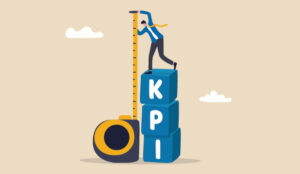Aksheeta Tyagi at Sprinklr looks into 10 important call centre KPIs to monitor and the formula to calculate each.
Immersed in the hectic routine of a call centre, it’s easy to lose sight of the bigger picture.
The art of customer service isn’t just about handling complaints, it’s also about building customer relationships and turning single transactions into lasting engagements.
That’s where tracking the right call centre key performance indicators can guide you through the chaos.
Call centre KPIs measure your achievements, expose areas for improvement, and drive accountability. Armed with these insights, you can make informed strategic decisions that boost revenue for you and your end clients.
10 Call Centre KPIs to Track
Here are the 10 call centre KPIs to foster a thriving customer-centric environment:
1. Net Promoter Score (NPS)
The Net Promoter Score or NPS reveals how strongly a customer feels about your services, and functions as a loyalty meter.
It is a tool for measuring your customers’ loyalty and serves as a barometer for your brand’s popularity.
It simply sums up responses to one crucial question, namely, “How likely are you to recommend a company to a friend or colleague?” The responses are marked on a scale of 0-10.
Let’s take a look at how customer responses can be categorized based on the Net Promoter Score (NPS):
- Promoters: These are the real champions of your brand. They give a glowing score of 9-10 and genuinely endorse your brand with enthusiasm and support.
- Passives: Customers in this category give a score of 7-8. They may not be actively promoting your brand, but they’re also not speaking negatively about it. They fall somewhere in the middle, with a neutral stance.
- Detractors: Unfortunately, there are customers who score 0-6, indicating they are not satisfied or happy with their experience. These individuals have the potential to impact your brand’s image if they resort to public forums to express their negative opinions. That’s why it’s essential to address their concerns and turn their perception around.
The NPS score is derived from this simple formula:
NPS= % of Promoters – % of Detractors
The resulting figure serves as a clear indicator of customer satisfaction. It may be a number, but it tells a story about customer experience, loyalty and brand perception.
2. Customer Satisfaction Score (CSAT)
At the heart of every call centre lies one guiding beacon, the Customer Satisfaction Score. It’s the litmus test of your service quality, mirroring the level of contentment among your customers post-interaction.
To compute your CSAT score, you can ask your customers to fill out a survey form, rating their product/support experience on a pre-defined scale.
A sample survey question can be “On a scale of 1-10, how satisfied do you think you are with our brand’s support?”
Based on the scores, respondents can be classified into different categories such as:
- Very Satisfied: This indicates that the customers had a fantastic experience with your service and they are extremely satisfied. You probably exceeded their expectations and turned them into your enthusiastic brand advocates.
- Satisfied: Customers in this category had a good experience with your service. They are content and feel that their expectations were met. While they may not be raving fans, they are generally happy with the service you provide.
- Neutral: These customers had an average experience. They neither feel strongly positive nor negative about your service. It was satisfactory but didn’t leave a lasting impression. It’s important to note that they may be easily swayed by other options.
- Unsatisfied: Unfortunately, these customers had a less than satisfactory experience. They expected more and feel let down by your service. Addressing their concerns and finding ways to improve their experience is crucial to retaining these customers.
- Very unsatisfied: These customers had a highly unsatisfactory experience. They are deeply dissatisfied and may even be frustrated or angry. Their negative feedback can significantly impact your brand’s reputation. It’s essential to address their concerns promptly and provide effective solutions.
Understanding and addressing customer feedback across these categories can help improve your service and cultivate positive experiences.
To calculate your CSAT score objectively, use this easy formula:
CSAT = (Total Number of Responses ÷ Number of Satisfied Customers) ×100
Remember, this number is not just a score but a narrative – a tale of your team’s ability to delight customers.
Therefore, engage, understand and keep delivering service that brings smiles. After all, a satisfied customer is your best advocate.
3. First Call Resolution (FCR)
The performance of a call centre revolves around many variables, but one metric that stands out is First Call Resolution or FCR.
Simply put, FCR is the percentage of customer issues resolved during their first call. It’s the magic moment when a customer sighs with relief, as their problem is solved without follow-up or the need for an escalation.
The essence of FCR is captured in this formula:
FCR = (Total Number of Calls Resolved on a First Call ÷ Total Number of Calls Handled) x100
But why does FCR matter? Because it reflects the principle of “doing it right the first time.” It prevents the frustration of multiple callbacks or transfers, creating happier customers.
So, keep an eye on FCR. Make it your guiding star.
4. First Response Time (FRT)
First Response Time can be likened to your customer’s first impression of your call centre. It measures the wait time for a customer before an agent attends to their call.
Imagine stepping into the shoes of a customer, eagerly reaching out for assistance. What would you hope for? A warm welcome, right? Well, that’s exactly what the First Response Time (FRT) aims to achieve.
Calculating the FRT involves a simple formula:
First response time = Total Time Taken to Respond to all Initial Customer Contacts ÷ Total Number of Initial Customer Contacts
But let’s dig deeper and explore why it matters.
In today’s fast-paced world, an immediate response feels like a comforting embrace. Whether it’s a live chat support or a phone call, customers expect quick resolutions. They want their questions answered, their concerns addressed and their needs met promptly.
However, FRT is not just about speed; it’s about understanding the customer’s thirst for instant help and meeting it head-on.
Improving customer response times sets the tone for a hopeful customer journey and also contributes to an overall happier experience.
Think about it – when you receive a quick response, it’s as if someone is right there, ready to assist you. It fosters a sense of importance that your needs are heard and acknowledged. This immediate attention can be a powerful catalyst for customer satisfaction.
So, strive to keep your FRT minimal. Embrace the challenge of providing rapid assistance and watch as your customers’ satisfaction levels soar. Remember, a swift response is often the crucial first step toward creating a delightful customer experience.
5. Percentage of Calls Blocked
The Percentage of Calls Blocked is a crucial metric on your customer service scorecard. It represents the proportion of incoming calls that encounter a busy signal, signaling potential issues in handling call volumes and customer satisfaction.
Here’s how to calculate this metric:
Percentage of Calls Blocked = (Number of Calls that Fail to Reach Agents ÷ Total Number of Incoming Calls) ×100
Imagine the frustration of dialing a number, eagerly seeking assistance, only to be met with a maddeningly persistent busy signal.
It’s like hitting a brick wall for your customers and is a missed opportunity for you to connect, assist and create a positive experience.
That’s precisely why you should care about this call centre KPI – the Percentage of Calls Blocked. It’s not just a cold, impersonal number on a spreadsheet.
It represents the very essence of human sentiment, reflecting the missed chances to provide support and make someone’s day a little brighter.
A high percentage here is a glaring sign that something needs attention. Perhaps your call centre is understaffed, leaving customers hanging in frustration.
Or maybe your call centre software is struggling to handle the call volume, leading to missed connections.
By tracking this crucial KPI, you gain insight into the pulse of your customer experience. It becomes a tangible measure of how well you’re meeting their needs.
Remember, every blocked call signifies a missed opportunity to create a happier customer experience. So, strive to lower this metric and keep the lines open for meaningful connections.
6. Call Abandonment Rate
The Call Abandonment Rate KPI refers to the number of customers who disconnect before reaching an agent.
The formula to calculate this call centre KPI is:
Call Abandonment Rate = ((No. of Inbound Calls − No. of Calls Abandoned in 5 Seconds or Less − No. of Calls Successfully Handled) ÷ (No. of Inbound Calls – No. of Calls Abandoned in 5 Seconds or Less)) x100
Being stuck on hold as a customer is not just frustrating, but disheartening. When customers hang up, it signifies a potential loss of trust in your brand’s service.
The call centre KPI of abandoned calls is a paradox – a low rate doesn’t guarantee high customer satisfaction.
Each abandoned call is an opportunity for improvement. Reflect on the reasons behind them: excessive wait times, lack of information or something else.
Use these insights to bridge the gap and create an experience that builds trust and leaves customers satisfied.
7. Average Speed of Answer (ASA)
As a customer, waiting for a call to be answered can feel like an eternity. Time seems to stretch endlessly, and impatience starts to creep in.
That’s why call centres monitor the Average Speed of answer — the average time it takes for calls to be answered.
Here’s the formula:
ASA = Total Wait Time for all Calls ÷ Total Number of Answered Calls
ASA isn’t just about holding music; it covers the time spent waiting in queue till the agent picks up the call. Though it excludes the interactive voice response (IVR) system navigation time, it clearly shows the team’s efficiency.
It’s similar to First Response Time (FRT), spotlighting the swift addressing of customer calls. However, ASA carries a specific weight. It conveys how quickly your team moves to bring a hopeful resolution to a customer’s concern.
8. Average Handle Time (AHT)
One of the most crucial call centre KPI is Average Handle Time. This is the total duration, on average, that an agent spends with a customer.
The calculation is as follows:
AHT = ((Total Talk Time + Total Hold Time + Total After-Call Work) ÷ (No. of Inbound Calls – No. of Calls Abandoned in 5 Seconds or Less)) x100
AHT is a valuable gauge to set performance benchmarks for the entire team and to identify who may need more customer service coaching.
It’s a metric that matters: a low AHT can indicate efficiency, leading to better productivity and happier customers.
However, it’s essential to balance this speed with quality solutions. After all, the aim is to help customers effectively, not rush them through the process.
9. Customer Effort Score (CES)
Customer Effort Score is a critical call centre KPI that measures how much effort a customer has to put in to get their issue resolved.
It’s based on this simple question:
“On a scale of 1 to 7 (7 means ‘Strongly Agree’ and 1 signifies ‘Strongly Disagree’), did our service make it easier for you to solve your problem?”
The score is then calculated as follows according to the customer responses:
CES = Total Sum of Effort Ratings ÷ Total Number of Responses
The ultimate goal is to minimize customer effort. Factors such as long queue times and frequent transfers can increase customer effort, negatively impacting the CES.
On the other hand, having well-trained agents who efficiently address customer needs can significantly reduce customer effort, leading to an improved CES.
It’s all about creating a seamless experience where customers feel supported and their problems are resolved with minimal hassle.
In essence, CES reflects how straightforward it makes the customer resolution process.
Therefore, it’s crucial to consistently meet customer expectations, not merely exceed them for a slight boost in loyalty.
10. Customer Churn Rate (CCR)
Keeping a pulse on the Customer Churn Rate is vital in the call centre KPI scorecard. This metric reveals the percentage of customers who’ve stopped using your services within a specific period.
Use this formula to calculate the CCR:
Customer Churn Rate = ((Customers at the Beginning of the Period – Customers at the End of the Period) ÷ Customers at the Beginning of the Period) x100
If your CCR is high, it’s a sign that your customers are not satisfied with your service, possibly due to unresolved issues or poor communication.
Agent performance plays a crucial role in reducing CCR. Agents are your business’s voice and face, and their ability to address customer complaints effectively can significantly reduce the customer churn rate.
Concluding Note
To achieve success in the call centre industry, it is crucial to prioritize customer satisfaction, agent performance, and operational efficiency.
Tracking call centre KPIs is essential for optimizing call centre operations and delivering exceptional customer experiences.
By focusing on the above-mentioned call centre KPI examples, you can identify areas for improvement and drive meaningful results.
Frequently Asked Questions
Can Technology Advancements Influence the Choice of Call Centre KPIs?
Yes, technology advancements can influence the choice of call centre KPIs by enabling more accurate data collection, real-time monitoring and analysis of customer interactions, leading to the identification of new metrics and the refinement of existing ones.
Can Call Centre KPIs Help Predict Customer Needs and Trends?
Yes, call centre KPIs can help predict customer needs and trends by analyzing patterns in customer interactions, such as common inquiries, complaints or feedback. This data can inform proactive strategies to address emerging needs and anticipate future trends.
How Often Should Call Centre KPIs Be Reviewed and Updated?
Call centre KPIs should be reviewed and updated regularly, ideally on a monthly or quarterly basis, to ensure they remain aligned with business goals, evolving customer needs and industry best practices.
Additionally, KPIs should be adjusted as necessary based on performance trends and feedback from stakeholders.
What Are Innovative Ways to Visualize Call Centre KPI Data for Better Decision-Making?
- Interactive dashboards with real-time data updates and drill-down capabilities.
- Heat maps to highlight peak call times or areas with high customer satisfaction.
- Trend analysis charts to track KPI performance over time and identify patterns.
- Gamification elements to encourage agent engagement and performance improvement.
Author: Sprinklr
Published On: 22nd Jul 2024 - Last modified: 22nd Oct 2024
Read more about - Guest Blogs, Aksheeta Tyagi, Sprinklr















